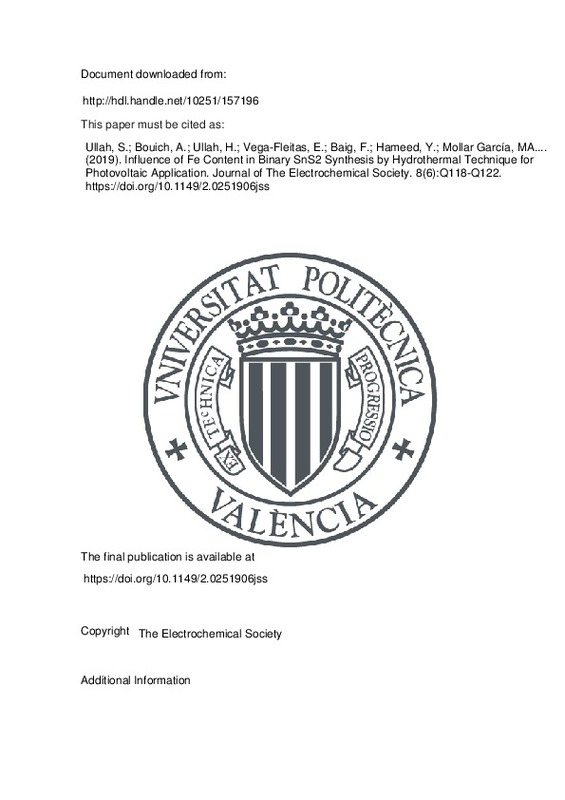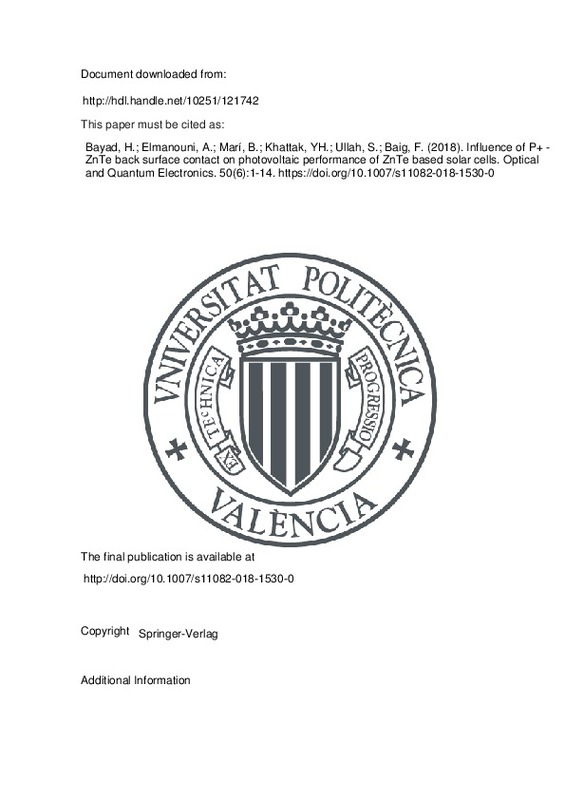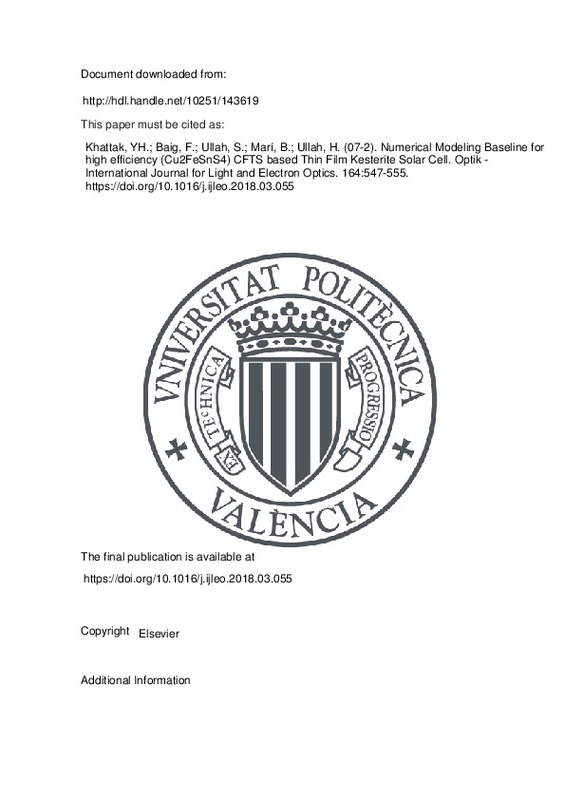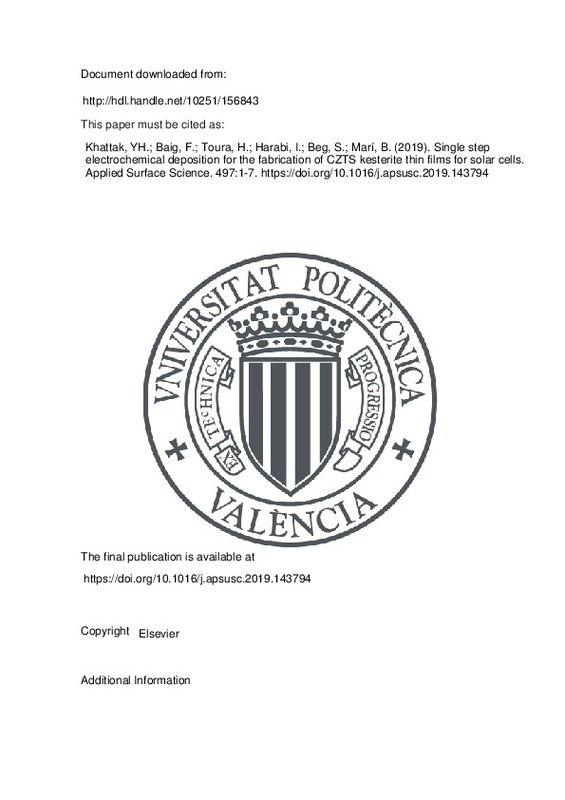

Listar por autor "Baig, Faisal"
RiuNet: Repositorio Institucional de la Universidad Politécnica de Valencia
- RiuNet repositorio UPV
- :
- Listar por autor
JavaScript is disabled for your browser. Some features of this site may not work without it.
Buscar en RiuNet
Listar
Mi cuenta
Ayuda RiuNet
Admin. UPV
Listar por autor "Baig, Faisal"
Mostrando ítems 1-18 de 18
-
Fradi, Khawla; Bouich, Amal; Khattak, Yousaf Hameed; Baig, Faisal; Slimi, Bechir; Marí, B.; Chtourou, Radhouane (SpringerOpen, 2024-08-05)[EN] Perovskite materials have emerged as promising candidates for next-generation photovoltaic devices due to their unique optoelectronic properties. In this study, we investigate the incorporation of bromine into cesium ...
-
Jemai, Safa; Hajjaji, Anouar; Baig, Faisal; Harabi, Imen; Marí, B.; Bessais, Brahim (Elsevier, 2021-05)[EN] This paper reports on a systematic study highlighting dramatic morphological changes during the preparation of Lead Sulfide (PbS) by a hydrothermal process. PbS micro/nanostructures having different shapes and sizes ...
-
Bouich, Amal; Cerutti Torres, Joeluis; Chfii, Hasnae; Marí-Guaita, Julia; Khattak, Yousaf Hameed; Baig, Faisal; Marí, B.; Palacios, Pablo (Elsevier, 2023-01-15)[EN] Herein, we propose a successful technique to produce delafossite materials that can be applied as Hole Transport Layer (HTL) in inorganic lead halide Perovskite solar cells (PSCs). The delafossite CuMO2, where M = Al, ...
-
Khattak, Yousaf Hameed; Baig, Faisal; Bouich, Amal; Marí-Guaita, Julia; Shuja, Ahmed; Marí, B. (Elsevier, 2023-11-15)[EN] This paper presents a thorough numerical investigation of copper zinc tin sulfide (CZTS)-based solar cells utilizing the SCAPS-1D simulation tool. In light of the scarcity of indium and gallium, CZTS is explored as a ...
-
Khattak, Yousaf Hameed; Baig, Faisal; Shuja, Ahmed; Atourki, Lahoucine; Riaz, Kashif; Marí, B. (American Chemical Society, 2021-08-24)[EN] Numerical analysis is a tool that is helping engineers over the past decades in design optimization and low-cost fabrication of solar cell devices. The need of modeling tools is used to deeply analyze a device in a ...
-
Khattak, Yousaf Hameed; Baig, Faisal; Marí, B. (American Scientific Publishers, 2018)[EN] The earth abundant materiel Cu2ZnSnSe4 (CZTSe) is a promising quaternary semiconductor compound having kesterite symmetrical structure. CZTSe is considered as suitable absorber material for photovoltaic cell applications ...
-
Khattak, Yousaf Hameed; Baig, Faisal; Toura, Hanae; Beg, Saira; Marí, B. (Springer-Verlag, 2019-12)[EN] Copper barium tin sulfide (CBTS) is a direct band gap earth abundant, non-toxic and quaternary semiconductor compound. It is used as absorber because of its direct band gap of 1.9 eV. A numerical guide is proposed for ...
-
Khattak, Yousaf Hameed; Baig, Faisal; Ullah, Shafi; Marí, B.; Ullah, Hanif (American Institute of Physics, 2018)[EN] Cu2ZnSnS4(CZTS) is a non-toxic earth abundant material and a promising quaternary semiconductor compound of groups I - II - IV - VI having a kesterite symmetrical structure. Due to its optimum direct bandgap, it has ...
-
Ullah, Shafi; Bouich, Amal; Ullah, Hanif; Vega-Fleitas, Erica; Baig, Faisal; Hameed, Yousaf; Mollar García, Miguel Alfonso; Marí, B. (The Electrochemical Society, 2019-06-18)[EN] Binary thin disulfide (SnS2) and ternary Sn1-x FexS2 (X = Fe (2.5%, 5% and 10%) which has huge potentials in the visible-light rang due to its bandgap 2.2-2.6 eV. Herein, SnS2 and Sn1-x FexS2 powders have been synthesize ...
-
Bayad, Hamza; Elmanouni, Ahmed; Marí, B.; Khattak, Yousaf Hameed; Ullah, Shafi; Baig, Faisal (Springer-Verlag, 2018)[EN] In order to improve photovoltaic performance of solar cells based on ZnTe thin films two device structures have been proposed and its photovoltaic parameters have been numerically simulated using Solar Cell Capacitance ...
-
Bouich, Amal; Marí-Guaita, Julia; Baig, Faisal; Khattak, Yousaf Hameed; Marí, B.; Palacios, Pablo (MDPI AG, 2022-09)[EN] Presently, we inquire about the organic/inorganic cation effect on different properties based on structure, morphology, and steadiness in preparing a one-step solution of APbI(3) thin films, where A = MA, FA, Cs, using ...
-
Hameed, K. Yousaf; Baig, Faisal; Toura, Hanae; Marí, B.; Beg, Saira; Khani, Naveed Ali Kaim (Springer-Verlag, 2019-11)[EN] In this work, a novel structured Cu2BaSnS4 (CBTS)/ZnS/Zn(O, S) photovoltaic device is proposed. A nontoxic, earth-abundant and auspicious quaternary semiconductor compound copper barium tin sulphide (Cu2BaSnS4) is ...
-
Baig, Faisal; Khattak, Yousaf Hameed; Ullah, Shafi; Marí, B.; Ullah, Hanif (Springer-Verlag, 2018)[EN] In this paper a numerical modelling guide is proposed about how to improve the efficiency of experimentally designed solar cells with the aid of numerical analysis. To validate the study presented in this paper, we ...
-
Baig, Faisal (Universitat Politècnica de València, 2019-04-01)[ES] Desde hace una década se esta investigando intensamente la forma de mejorar la eficiencia de conversión de energía (PCE) de las células solares de silicio (Si) y reducir sus precios. Sin embargo, a pesar de las mejoras ...
-
Baig, Faisal; Khattak, Yousaf Hameed; Beg, Saira; Marí, B. (Elsevier, 2019-11)[EN] Sb2Se3 antimony selenide is a great potential for solar cell commercial application with good absorption coefficient and optimal band gap. In recent years the maximum power conversion efficiency (PCE) achieved from ...
-
Khattak, Yousaf Hameed; Baig, Faisal; Ullah, Shafi; Marí, B.; Ullah, Hanif (Elsevier, 2018-07)[EN] Cu2FeSnS4 (CFTS) is auspicious nontoxic and earth abundant semiconductor compound having kesterite symmetrical structure. It is an attractive and suitable material for the fabrication of low cost, high efficiency and ...
-
Khattak, Yousaf Hameed; Vega, Erika; Baig, Faisal; Marí, B. (Elsevier, 2022-07)[EN] A fabricated perovskite solar cell structure Spiro- OMeTAD/MAPbI(3)/TiO(2 )showing a maximum efficiency of 14.7%, employing a cost-effective single-step spin-coating method, with controlled humidity of 35% under ambient ...
-
Khattak, Yousaf Hameed; Baig, Faisal; Toura, Hanae; Harabi, Imen; Beg, Saira; Marí, B. (Elsevier, 2019-12-15)[EN] The high absorption coefficient and direct optical band gap of a kesterite Cu2ZnSnS4 (CZTS) makes it very promising absorber material in the manufacturing of high efficiency and low-cost thin film photovoltaic cells. ...
Mostrando ítems 1-18 de 18

Universitat Politècnica de València. Unidad de Documentación Científica de la Biblioteca (+34) 96 387 70 85 · RiuNet@bib.upv.es












